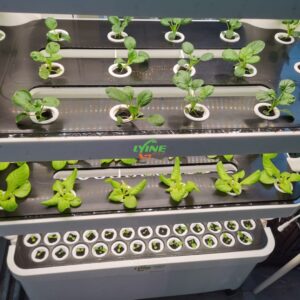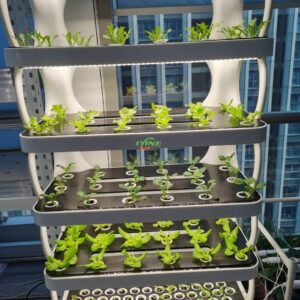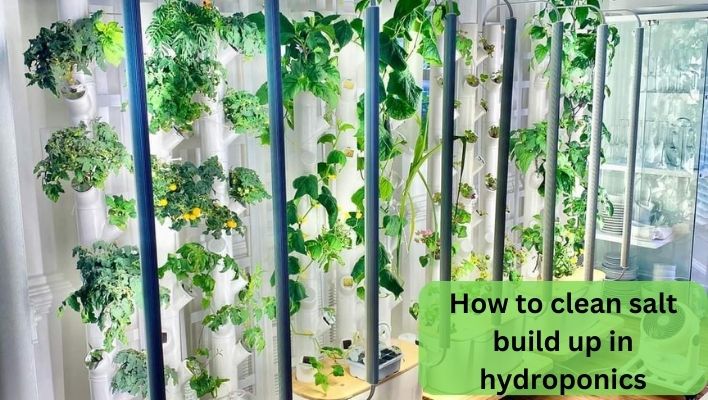Hydroponic gardening is a fantastic way to grow plants without needing soil. It’s a popular method for indoor gardening and can produce healthy and abundant yiealds. However, one of the most common issues hydroponic gardeners face is salt buildup in their systems.
This can be caused by using fertilizers or water high in mineral content. When left unaddressed, the salt buildup can damage the plants and affect their growth. One of the essential aspects of maintaining a hydroponic system is keeping it clean.
A clean hydroponic system is crucial for plant growth and can prevent the buildup of harmful elements such as salt.
Salt buildup can be a common problem in hydroponics, which occurs when the concentration of nutrients in the solution increases over time, causing salt to accumulate on the system’s surface.
This article will discuss the importance of maintaining clean hydroponic systems and how to clean salt build-up in hydroponics.
Following this article’s steps, you can prevent salt build-up in your hydroponic system and ensure your plants grow strong and healthy.
So if you’re a hydroponic gardener struggling with this issue, keep reading to learn how to keep your plants thriving and healthy.
What is salt build-up in hydroponics?
Salt in hydroponics refers to the buildup of excess minerals and nutrients in the growing medium or nutrient solution. These minerals and nutrients are essential for plant growth, but if they accumulate in high concentrations, they can become harmful to the plants.
Salt buildup can occur in hydroponic systems due to the lack of soil to naturally filter and remove excess nutrients, as well as the constant recirculation of the nutrient solution. Common minerals that can contribute to salt buildup include calcium, magnesium, potassium, and sodium.
Salt build-up is a common problem that occurs in hydroponic systems. It happens when the concentration of nutrients in the nutrient solution increases, causing salts to accumulate in the growing medium and on the system’s surface. Over time, these salts can build up and cause damage to your hydroponic plants.
Causes of salt build-up: Salt build-up occurs due to several reasons, including:
- Overfeeding: Adding too many nutrients to the solution can lead to a build-up of salts. This is because the plants can only absorb a certain amount of nutrients, and the excess nutrients will stay in the solution, leading to salt build-up.
- Poor quality water: The quality of the water used in your hydroponic system can also contribute to salt build-up. If your water has a high level of dissolved minerals, it can lead to salt accumulation over time.
- pH imbalance: If the pH level of your nutrient solution is too high or too low, it can affect the uptake of nutrients by the plants. This can lead to an imbalance in nutrient concentration, resulting in the salt build-up.
Symptoms of salt build-up:
The symptoms of salt build-up can be similar to those caused by nutrient deficiencies, making it challenging to diagnose. However, some common symptoms include the following:
- Burnt leaf tips: The edges of the leaves may turn brown or black, indicating that high salt levels are burning the plants.
- Stunted growth: Salt build-up can hinder the plant’s ability to absorb nutrients, leading to stunted growth.
- Yellowing leaves: The leaves may turn yellow, indicating that the plants are not receiving enough nutrients due to the high salt levels in the system.
Effects of salt build-up on plants:
Salt build-up can have several negative effects on hydroponic plants just as pests do, including:
- Reduced growth: Salt build-up can hinder the plant’s ability to absorb nutrients, leading to reduced growth.
- Damage to root system: The accumulation of salts in the growing medium can damage the root system, making it difficult for the plants to take up nutrients and water.
- Lowered yields: If salt build-up is not addressed, it can lead to lower yields or even the death of your hydroponic plants.

How to detect salt build-up in hydroponics
Detecting salt build-up in hydroponics ensures your plants grow healthy and strong. Here are two methods to detect salt build-up in hydroponics:
Testing the pH and EC levels of the nutrient solution:
One of the easiest ways to detect salt build-up in hydroponics is by testing the nutrient solution’s pH and electrical conductivity (EC) levels. You will need a pH meter and an EC meter to do this.
The pH meter will measure the acidity or alkalinity of the nutrient solution, while the EC meter will measure the concentration of dissolved salts in the solution. If the EC level is too high, it can indicate that there is a salt build-up in the system. The pH level should be between 5.5 and 6.5 for most hydroponic plants.
Conducting a visual inspection of the hydroponic system:
Another way to detect salt build-up in hydroponics is by visually inspecting the hydroponic system. You should look for the following signs:
- White or yellowish deposits on the growing medium or around the plant roots
- A crusty layer on the surface of the growing medium
- A salty or mineral-like smell in the hydroponic system
If you notice any of these signs, salt build-up is likely in your hydroponic system.
How to clean salt build-up in hydroponics
If you detect salt build-up in your hydroponic system, cleaning it as soon as possible is crucial to prevent any damage to your plants. Here’s a step-by-step guide on how to clean salt build-up in hydroponics:
Step 1: Drain the hydroponic system.
The first step is to drain the nutrient solution from the hydroponic system. This will help you eliminate any excess salt build-up in the system.
Step 2: Remove the plants and growing medium
Next, remove the plants and growing medium from the hydroponic system. This will allow you to clean the system more thoroughly.
Step 3: Flush the hydroponic system.
Fill the hydroponic system with fresh water and let it run through the system for at least an hour. This will help flush out any remaining salt build-up in the system.
Step 4: Clean the hydroponic system.
Mix a cleaning solution of one part white vinegar and nine parts water. Use this solution to clean the hydroponic system thoroughly, including the reservoir, tubing, and pump.
Step 5: Rinse the hydroponic system.
Once you’ve finished cleaning it, rinse it thoroughly with fresh water. Ensure no cleaning solution is left in the system before refilling it with nutrient solution.

Precautions to take while cleaning:
- Use protective gloves and goggles while handling the cleaning solution to avoid any injuries or irritation.
- Avoid using harsh chemicals or cleaning agents that can damage the hydroponic system or harm the plants.
- Make sure to clean the hydroponic system regularly to prevent any salt build-up from occurring.
Precautions to take while cleaning:
- Always wear gloves and protective eyewear when cleaning the hydroponic system and using cleaning solutions.
- Use a mild detergent or hydrogen peroxide instead of harsh chemicals to clean the hydroponic system.
- Be sure to rinse everything thoroughly with water to remove any cleaning solution residue before reassembling the hydroponic system.
By following these steps and precautions, you can effectively clean salt build-up from your hydroponic system and ensure healthy plant growth.
Other ways to clean your system
In addition to flushing your hydroponic system with a vinegar or citric acid solution, there are other ways to clean salt build-up and prevent it from recurring. Here are some additional methods to consider:
Hydrogen peroxide solution:
Hydrogen peroxide can be used to clean your hydroponic system and also helps to aerate the roots of your plants. Mix one tablespoon of 3% hydrogen peroxide with one gallon of water and run the solution through your system for at least 24 hours. Rinse the system thoroughly with fresh water before reintroducing your plants.
Citric acid solution:
Citric acid is a natural and safe alternative to harsh chemical cleaners. Mix one tablespoon of citric acid powder with one gallon of water and run the solution through your hydroponic system for at least 24 hours. Rinse the system thoroughly with fresh water before reintroducing your plants.
Enzyme cleaners:
Enzyme cleaners can be effective at breaking down salt buildup in your hydroponic system. Follow the instructions provided by the manufacturer and run the solution through your system for the recommended time. Rinse the system thoroughly with fresh water before reintroducing your plants.
Mechanical Cleaning:
If salt build-up is severe, mechanical cleaning may be necessary. This involves manually scrubbing or scraping the affected areas to remove the build-up. Be careful not to damage any components of your hydroponic system while doing so.
It’s important to note that when cleaning your hydroponic system, you should always use clean and sterile tools to prevent the spread of disease.
Regardless of the method you choose, it’s important to regularly monitor and maintain your hydroponic system to prevent salt build-up from occurring in the first place.
Proper water quality, nutrient balance, and pH levels are key to preventing salt build-up and ensuring healthy plant growth. Happy cleaning.
Preventing salt build-up in hydroponics
Preventing salt build-up in hydroponics ensures your plants grow healthy and strong. Here are some tips to prevent salt build-up in your hydroponic system:
- Use high-quality nutrient solutions: Using high-quality nutrient solutions can prevent salt build-up in hydroponics. Avoid using low-quality or outdated nutrient solutions, as they can contain high salts and other impurities.
- Monitor nutrient levels regularly: Regularly monitoring the nutrient levels in your hydroponic system can help prevent salt build-up. Use an EC meter to measure and adjust the nutrient levels as needed.
- Maintain the right pH levels: Maintaining the right pH levels is also essential to prevent salt build-up. Most hydroponic plants grow best in a pH range of 5.5 to 6.5. Use a pH meter to measure the pH levels of your nutrient solution regularly and adjust them as needed.
- Use a flushing agent: Flushing agents can also prevent salt build-up in hydroponics. Flushing agents help remove excess salts from the hydroponic system, ensuring the plants receive the nutrients they need without being harmed by salt build-up.
- Change the nutrient solution regularly: Changing the nutrient solution regularly can also prevent salt build-up in hydroponics. Changing the nutrient solution every two to three weeks or as needed is recommended.
These tips can prevent salt build-up in your hydroponic system and ensure healthy plant growth. Remember to monitor your nutrient levels and pH regularly, use high-quality solutions, and change the solution regularly.

How to clean salt buildup in hydroponics FAQs
How often should I clean my hydroponic system?
Cleaning your hydroponic system should be done regularly to prevent salt build-up. It’s recommended to clean your system every two to three weeks or as needed, depending on the plant’s growth rate and the type of hydroponic system you’re using.
Regular cleaning helps maintain a healthy environment for your plants and ensures that they receive the right nutrients.
However, the cleaning frequency may vary depending on the type of hydroponic system you have and the type of plants you’re growing. It’s always best to monitor your hydroponic system regularly and clean it as needed.
Can I reuse the nutrient solution after cleaning?
Yes, you can reuse the nutrient solution after cleaning. However, you need to ensure that you’ve removed all the salt build-up and debris from the nutrient solution.
It’s also recommended to adjust the nutrient levels and pH after cleaning and before reusing the solution to ensure that your plants receive the right nutrients.
What type of descaler solution should I use?
There are different types of descaler solutions available in the market. However, it’s recommended to use a descaler solution specifically designed for hydroponics systems.
These solutions are usually mild and safe for your plants. Avoid using harsh chemicals or household cleaners, as they can damage your hydroponic system and harm your plants.
Always read the label and follow the manufacturer’s instructions when using descaler solutions.
How do I prevent salt build-up in the future?
Preventing salt build-up in hydroponics requires regular maintenance and monitoring of the nutrient levels and pH.
Use high-quality nutrient solutions, monitor nutrient levels regularly, maintain the right pH levels, use flushing agents, and change the nutrient solution regularly to prevent salt build-up in the future.
What is the best time to clean salt build-up?
The best time to clean salt build-up is during the plants’ vegetative stage before they start to flower. This stage allows the plants to recover from the cleaning process and resume their growth without being stressed.
Can I use regular cleaning solutions to clean salt build-up in my hydroponics system?
No, you should not use regular cleaning solutions to clean salt build-up in your hydroponics system. Regular cleaning solutions contain harsh chemicals that can damage your hydroponic system and harm your plants. Use a descaler solution specifically designed for hydroponics systems to ensure that your plants remain healthy and safe.
How long does it take to clean salt build-up?
The time it takes to clean salt build-up depends on the severity of the build-up and the type of hydroponic system you’re using.
Generally, it can take 30 minutes to 1 hour or more to clean salt build-up, depending on the hydroponics system you are using.
However, it’s important to follow the recommended cleaning procedures and take the necessary precautions to ensure that your plants remain healthy and safe.
Conclusion
Maintaining a clean hydroponic system is crucial for healthy plant growth, and salt build-up can be a significant obstacle to achieving this goal. It’s essential to detect and clean salt build-up regularly to ensure that your plants receive the nutrients they need for healthy growth.
Regular cleaning and maintenance of your hydroponic system can prevent salt build-up and ensure that your plants grow strong and healthy. Following the steps provided in this article is crucial to detect, clean, and prevent salt build-up in your hydroponic system.
Maintaining a clean hydroponic system is crucial for successful plant growth and long-term success in hydroponics. We encourage you to take the necessary steps outlined in this article to keep your hydroponic system clean and healthy for your plants. Feel free to reach out to experts or consult product labels if you need more guidance on cleaning your hydroponic system.
